1>以下所讲内容是针对RPG的dump,至于CL的Dump,可以用CL command DMPCLPGM 貌似是。。
2> 遇到问题不要老是第一时间想到DEBUG,特别是针对Batch job,DUMP 尤其重要
3> 一般程序运行出错,回答D会自动生成DUMP file (在对应的WRKJOB/4 SPOOL FILE),程序结束运行
4> 搜索当前情况下indicator的状况是个不错的选择。
5>需要更方便的查找,建议使用CPYSPLF 指令,可以将dump文件放到物理文件,方便查找
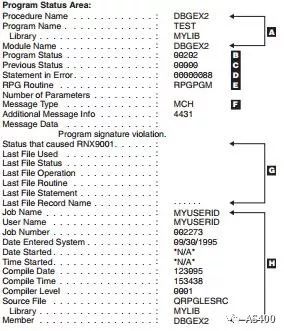
▌A▐Procedure Identification: the procedure name, the program and library name, and the module
name.
▌B▐Current status code.
▌C▐Previous status code.
▌D▐ILE RPG source statement in error.
▌E▐ILE RPG routine in which the exception or error occurred.
▌F▐CPF or MCH for a machine exception.
▌G▐Information about the last file used in the program before an exception or error occurred. In this case, no files were used.
▌H▐ Program information. '*N/A*' indicates fields for which information is not available in the
program. These fields are only updated if they are included in the PSDS
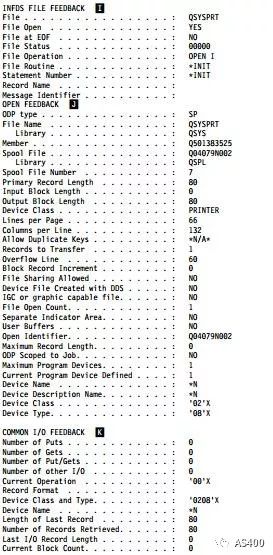

▌I▐ This is the file feedback section of the INFDS. Only fields applicable to the file type are printed.
The rest of the INFDS feedback sections are not dumped, since they are only updated if theyhave been declared in the program.
▌J▐ This is the file open feedback information for the file. For a description of the fields, refer to the
Db2 for i section of the Database and File Systems category in the IBM i Information Center at this
Web site - http://www.ibm.com/systems/i/infocenter/.
▌K▐ This is the common I/O feedback information for the file. For a description of the fields, see the
above Web site.
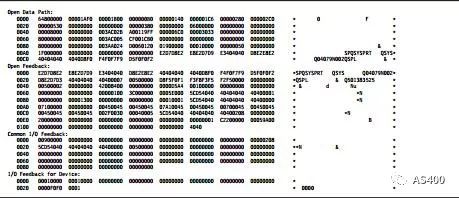
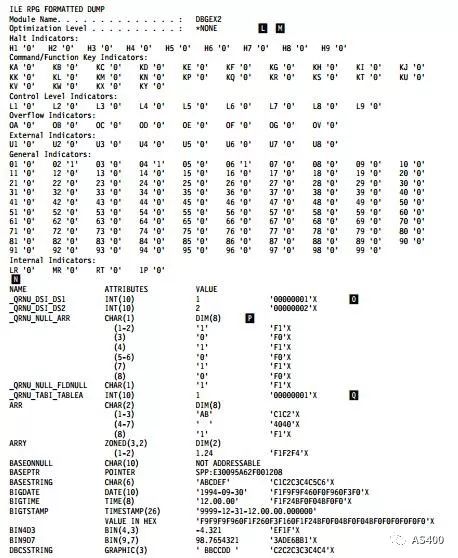
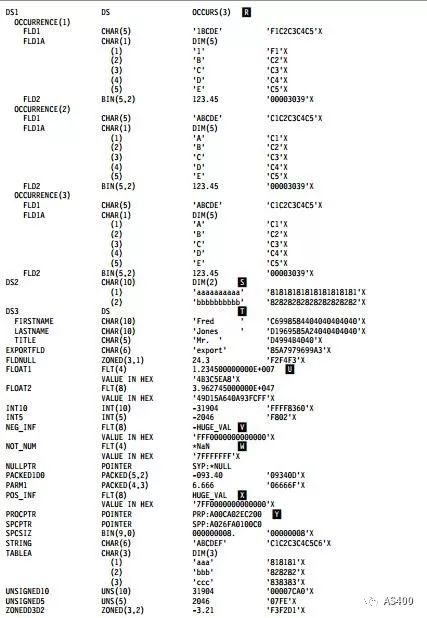

▌L▐Optimization level
▌M▐General
indicators 1-99 and their current status ('1' is on, '0' is off). Note
that indicators *IN02,*IN04, and *IN06 were not yet set.
▌N▐Beginning
of user variables, listed in alphabetical order, and grouped by
procedure. Data that is local to a subprocedure is stored in automatic
storage and is not available unless the subprocedure is active. Note
that the hexadecimal values of all variables are displayed. :nt Names
longer than 131 characters, will appear in the dump listing split across
multiple lines. The entire name will be printed with the characters
'...' at the end of the lines. If the final portion of the name is
longer than 21 characters, the attributes and values will be listed
starting on the
following line.
▌O▐Internally defined fields which contain indexes multiple-occurrence data structures.
▌P▐Internally defined fields which contain the null indicators for null-capable fields.
▌Q▐Internally defined fields which contain indexes for tables.
▌R▐Multiple-occurrence data structure.
▌S▐Data structures with no subfields are displayed as character strings.
▌T▐Data structure subfields are listed in alphabetical order, not in the order in which they are defined.
Gaps in the subfield definitions are not shown.
▌U▐4-byte and 8-byte float fields.
▌V▐Indicates negative infinity.
▌W▐Stands for 'not a number' indicating that the value is not a valid floating-point number.
▌X▐Indicates positive infinity.
▌Y▐The attribute does not differentiate between basing and procedure pointer.
▌Z▐The local data inside subprocedures is listed separately from the main source section.






